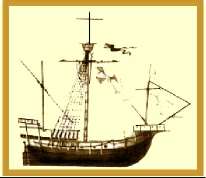|
PinkMonkey Study Guide - American History
1. 2 Voyages of Exploration
The Europeans by then had a general idea that the
Earth was round. Several expeditions were made to find an alternative
sea-route around Africa to the East. This would enable them to ignore
the Turks, establish trade relations with Africa and go on to the
Orient. Prince Henry took the initiative to explore the possibility
of new trade routes to the East.
This venture involved a lot of risk. Prince Henry
gathered sailors, astronomers, shipbuilders and mapmakers from all
over Europe. His men were able to develop smaller and stronger ships
called the caravel. Its new hull design and sail helped the ship
to sail faster with the wind. The Prince sponsored several expeditions
to the coasts of Africa. However, his dream of a new sea route to
the Orient was fulfilled 20 years after his death.
In 1497, Vasco da Gama set out in the quest of
spices and reached India. He returned 2 years later, with a ship
full of spices.
Before Vasco da Gama’s celebrated voyage, several
other mariners tried and failed in their attempts to find a sea
route to the Indies. One of them was Christopher Columbus.
He was a native of Genoa, who had worked under Prince Henry in Portugal.
Columbus believed that, since the Earth was round, it was possible
to find another course by sea to the East. But as no one knew the
existence of America then, he like many Europeans underestimated
the Earth’s circumference. The result was that Columbus reached
San Salvador in the West Indies. Columbus believed that he had touched
the Oriental coast. In fact, he had discovered a new continent.
Thus, Columbus discovered America on October 12, 1492.
Christopher Columbus made four voyages to the new continent.
They were between 1492-93, 1493-96, 1498 -1500 and from 1502-04. But until
his death in 1506, Columbus continued to believe that he had reached Asia
through an alternate route. It was Amerigo Vespucci, an Italian
working under the Spanish monarch, who cleared this misconception. Between
1497 and 1505, Amerigo visited the new continent four times. From here,
he wrote a series of letters to his friend in Italy describing the New
World. Published in 1507, these letters provided valuable information
to Europeans on the shape, size, flora and fauna of the continent. It
was Amerigo’s pioneering study and exploration of the New World, that
the continent got its name: America - after Amerigo.

Exhibit 1.2
A model of the "Santa Maria," the ship in which
Christopher Columbus made his first Atlantic voyage in 1492.
[next page]
|
Table of Contents
"Verdana" 1.0
- Chronology of Major Events in this Period
1.1 - The Discovery of America
1.2 - Voyages of exploration
1.3 - The Indians
1.4 - Points to Remember
Chapter 2
|